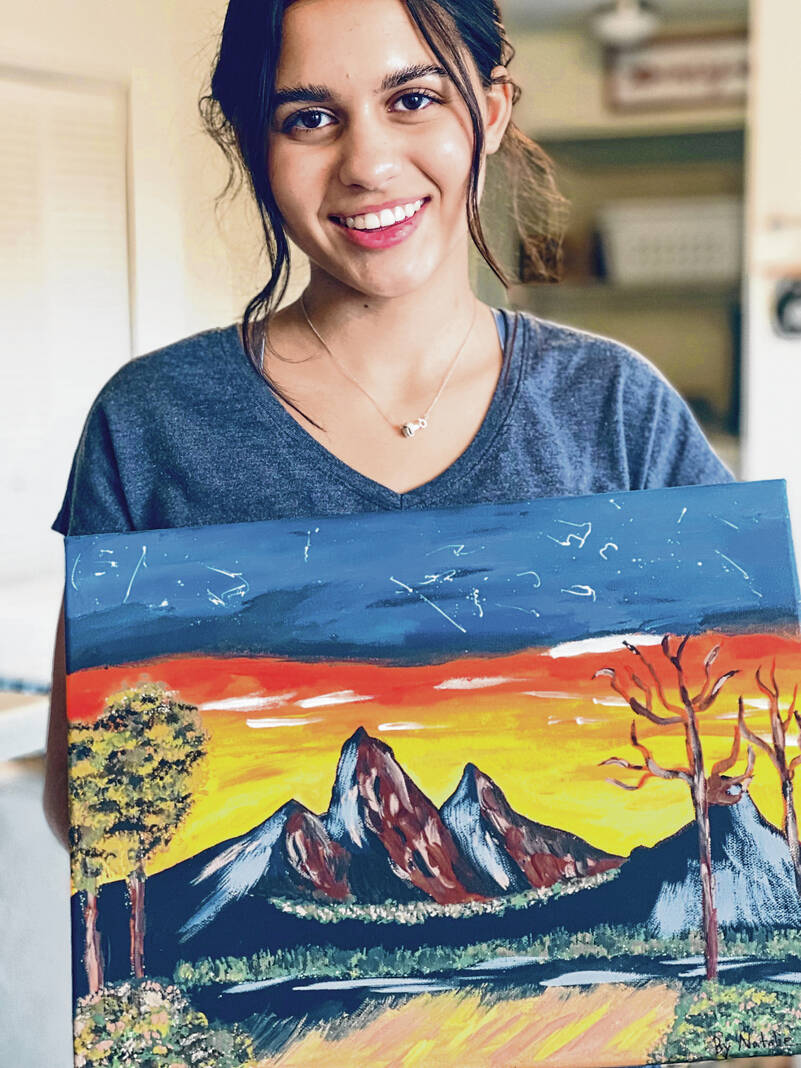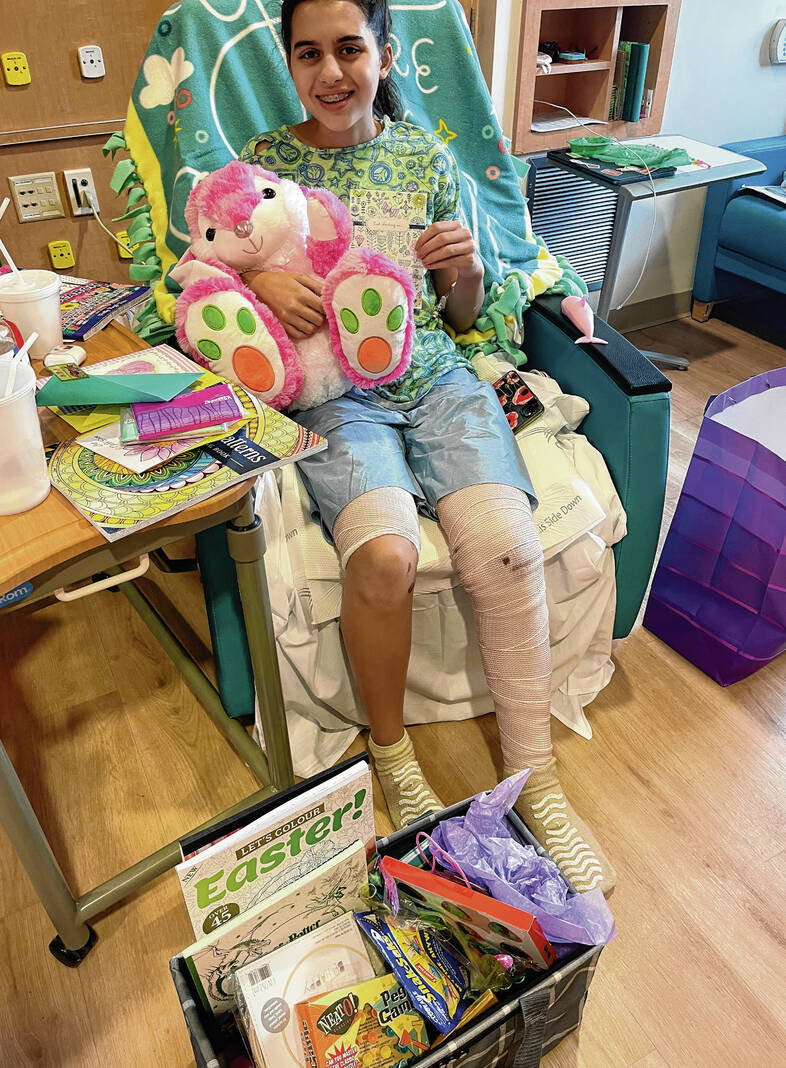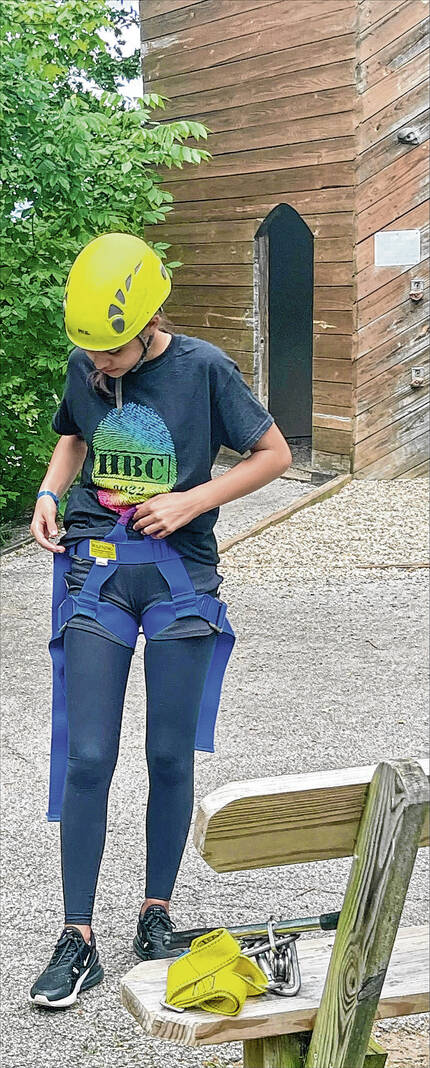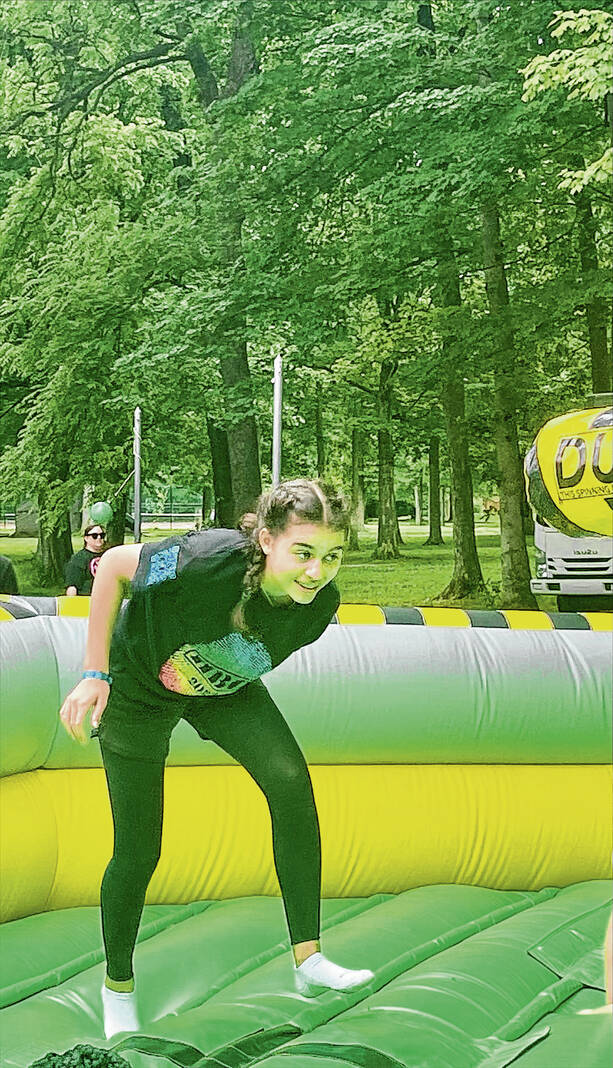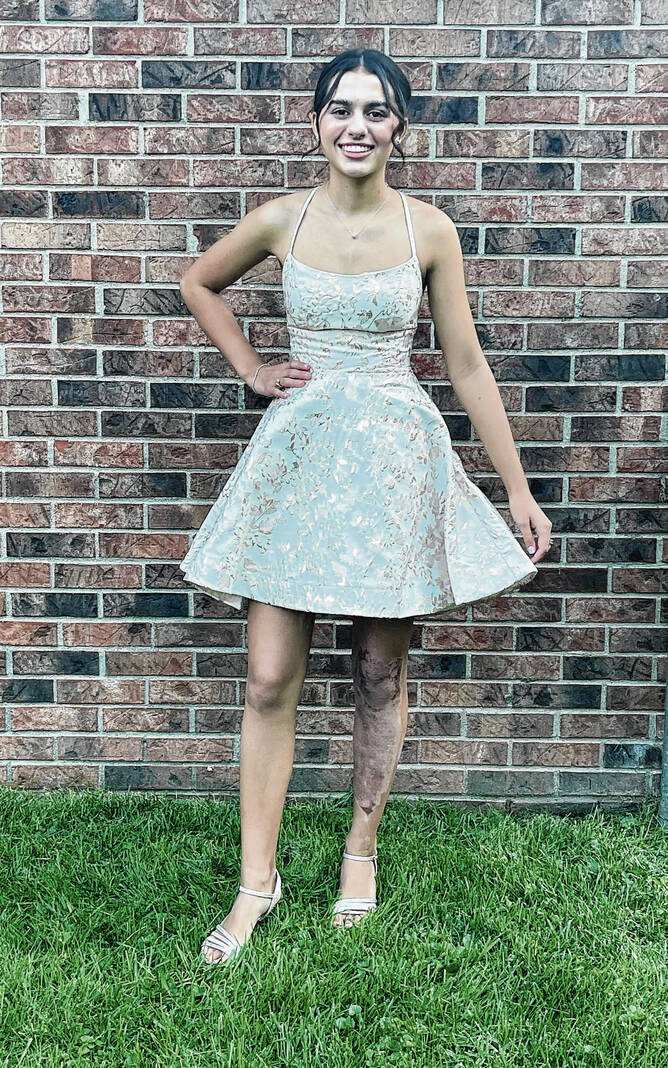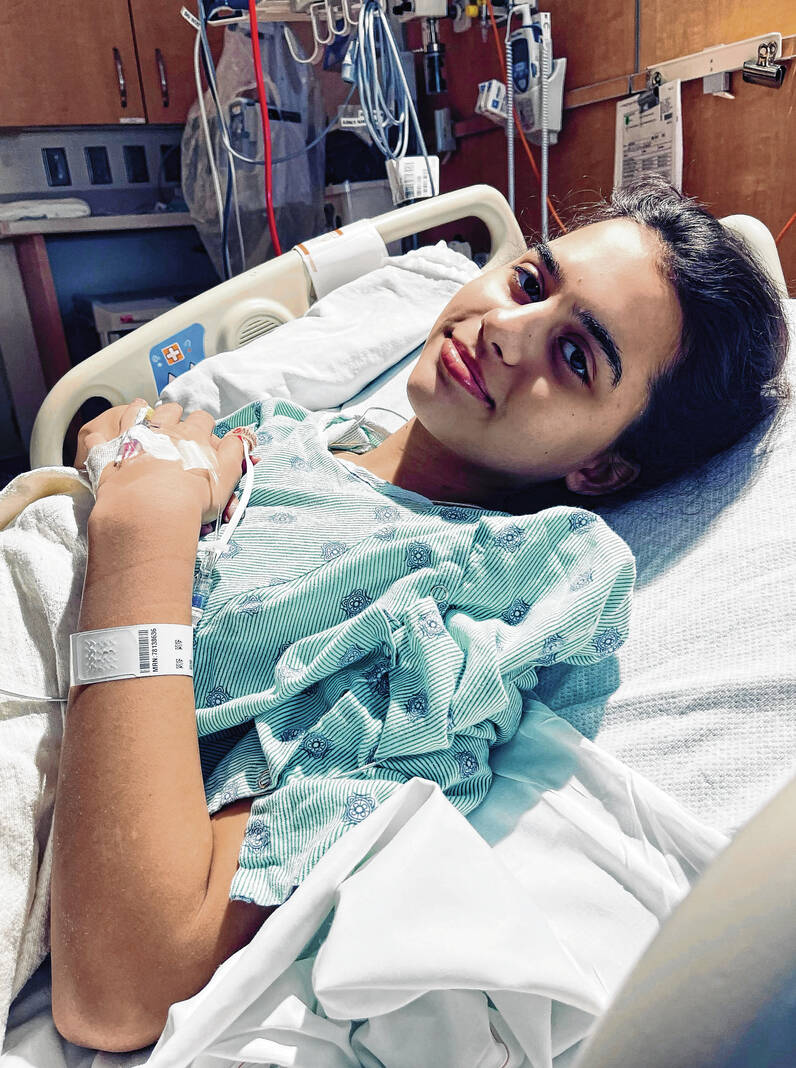
Natalie Maled in the Speedway Burn Unit at Riley Hospital for Children at IU Health in March 2022 after her leg was burned with hot oil. Maled, now a 15-year-old student at Center Grove High School, wants to use her experience to raise awareness of burns and safety around hot liquids.
SUBMITTED PHOTO
The searing pain of hot oil didn’t register, at first.
Natalie Maled was in shock that the scalding liquid had spilled from the fondue pot onto her left leg. What had been a fun night with her family had descended into panic.
Then, the agony caught up to her.
“It took me a couple of seconds to register what happened, then I screamed really loud — like I never had before,” she said. “I felt like I was going to pass out from the pain.”
Maled suffered second-degree burns across her left leg, extending from her ankle to her thigh, that night in March of 2022. She ended up spending 10 days in Riley Hospital for Children at IU Health’s Speedway Burn Unit, enduring multiple surgeries and skin grafts to repair her damaged body.
The experience changed the 15-year-old Center Grove High School student. But in a way, she’s embracing the trauma of it, using her situation to educate others about the risks burns and scalds.
“It was hard to see how this could be anything other than a terrible thing that happened. But after wave of awful pain was over, I realized I could do something good from this,” she said. “As much as I wish it hadn’t happened, I wouldn’t take it back, because I think it changed me for better.”
Despite the overwhelming knowledge that fire and other heat-producing objects and liquids cause burns, few people take time to consider the burn risks existing around us every day, said Dr. Brett Hartman, medical director of the Speedway Burn Unit at Riley Hospital for Children.
At the Speedway Burn Unit, a total of 127 patients were admitted in-patient for burns in 2022 — 63 of which were for scalds. Scalds are a type of burn caused by something wet, such as a liquid or steam.
Another 185 patients were treated at the hospital’s outpatient clinic for burns.
“A majority of the burns that we see are absolutely preventable,” Hartman said. “It’s very, very common, but a very preventable injury.
Maled and her family had no idea of the danger lurking among their casual fondue night. They had gathered for a nice meal on a Saturday night, sitting around the dining room table with the fondue pot sitting in the center.
The cord the pot was connected to a nearby outlet, passing next to Maled’s chair. When one of her dogs came by, she reached over to pet it. Her chair tipped and fell over, catching the cord and pulling the pot on top of her.
“Everything was chaos at that point,” she said.
Maled gathered herself and ran to their laundry room, stripping off her oil-laden clothes.
“As I stripped down, I could see the skin and pigment on my legs just roll off,” she said.
Her mother, Hope Clay, was with her in an instant. She helped her daughter take off the clothes, wrap in a towel and put on the baggiest, loosest clothes she could find.
The entire situation seemed to unfold in a dream.
“It was that slow-fast motion all at once, and the surrealness of ‘Is this happening?’” Clay said. “There was that flash moment that maybe it wasn’t that bad, because she had leggings on.”
Maled’s injuries were that bad. They rushed to Eskanazi Hospital, near where Clay lived at the time, where she received immediate treatment before being transferred to Riley Hospital for Children for more intensive care for what was determined to be second-degree burns.
The entire time, Maled screamed.
“She just wanted to be knocked out. It’s awful to hear your child in such pain and there’s nothing you can do, even when there’s a medical team around and they’re doing everything they can do,” Clay said. “She just had to feel that pain.”
At Riley, medical staff cleared off the damaged skin. They also tried a new procedure called “spray skin” to protect her burned leg. Taking small paper-thin strips of Maled’s own skin, the team processed it into a suspension they could spay over the burn wound.
The hope was the cells in the solution was take hold and start to grow, preventing the need for a more extensive skin graft.
“The advantage is that it’s a small donor site where we have to take skin, and it can cover 80 times that surface area that we’ve taken,” Hartman said.
The approach worked. Most of her injuries were covered with her own skin and started to heal. She only needed minimal skin grafts.
“I only had grafts on my upper thighs. The rest was spray skin; I can’t imagine what it would have been to have grafts all over my leg,” she said.
After 10 days, Maled was released from the burn unit. She slowly healed, though the injuries to her leg made every movement more deliberate and slow. Even walking to go to the bathroom took nearly an hour.
She and her parents also learned to properly change her dressings and bandages, preventing infection.
“The nurses did a wonderful job — but it was still very scary — of showing us the layers and layers of bandages and ointment,” Clay said. “The room looked like a hospital room when we prepared. The first few times we did it, it took a couple of hours.”
But slowly, her body healed. She was able to move more freely, and with less pain. By the beginning of May, she was able to go back to school.
Maled feels back to normal now, though she is still undergoing laser treatments at Riley Hospital for Children to help with the scarring from the accident.
Most importantly, she’s in a more healthy place mentally and emotionally.
“I feel happy now. It was really tough after the accident, just trying to figure out how to do different things again, and my body looked completely different. That was a mental challenge in some ways,” she said. “I’ve got scars, and lumps and bumps, but I can function perfectly fine.”
Through her experience, Maled hopes to impress how burns can happen even during innocuous situations. She never anticipated dinner with her family would shatter into tragedy.
Maled wants to shine a light on different ways burns can impact your life.
“It’s not something people don’t talk about, because it’s not a common thing that happens. You maybe burn your hand on the oven, or burn your earlobe with a hair straightener, something like that,” she said. “But when it comes to these big accidents, it’s not that common, so it’s not really talked about.”
AT A GLANCE
Burn prevention helpful tips
More than 73% of burn injuries occur in the home. Learn how to keep your family safe as you balance work and play within the home.
- Prevent scald burns in the kitchen by keeping hot items out of reach of children.
Use the back burners of the stove and keep pot handles turned away from the edge to keep hot food and liquid out of reach of children. - Have a “kid-free zone” of at least 3 feet around the stove and areas where hot food or drink is prepared or carried.
- Contact burns can be prevented by giving hot items time to cool down.
- Keep hot drinks off of low tables and away from the edges of countertops. Use a travel mug with a lid around children.
- Set hot water heater at 120 degrees or just below the medium setting. Always supervise children while they are bathing.
- To prevent electrical burns, be sure to tuck away cords and cover outlets.
- Keep children at a safe distance with a “circle of safety” at least 3 feet from the edges of firepits to prevent flame burns.
— Information from the American Burn Association


